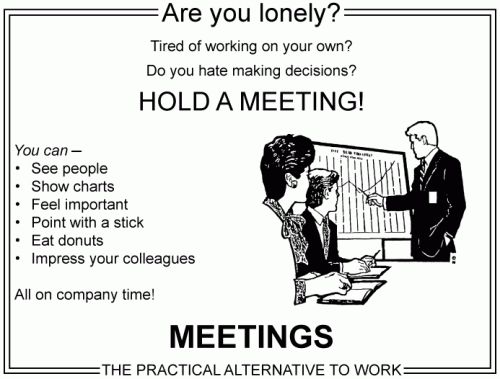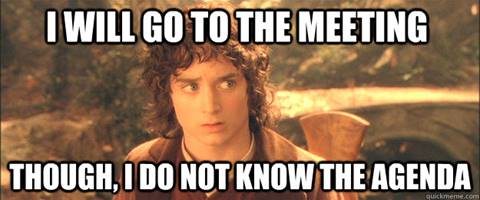Become a Meeting Sensei!
Everyday organizations around the country are running bad meetings. But how can that be? There are a constant stream of blogs and new books addressing the issue. However, meetings never seem to get better. Below is one of my favorite takes on meetings in general.

If you feel like your meeting are like this, then look no further, help is on the way!
Below are 5 basic rules to follow to make meetings more effective.
1 – Don’t schedule long meetings (anything over 2 hours is a no-no)
People get tired and disengage after sitting down for so long (especially if they are not providing anything to the meeting). It is best to take 4 topics and schedule 4 meetings over the day vs. trying to cram it into a single 4 hour session. If you have to try and resolve 4 items in 1 session, then put in breaks every 1.5 hours.
Fun tip! Make sure your team has ample time to prepare for the meeting (Don’t schedule a meeting 5 minutes before it starts)
2 – Have an agenda (with a small set of topics)
A title to the meeting is not an agenda. You may have only one topic but there should be some preparation on how the meeting should flow. Breaking down the different steps and assign a time estimate to each step can help determine if you have scheduled the right amount of time. Also feel free to get input from others on the agenda ahead of time. They could provide helpful input that can prevent issues during the meeting.
Don’t be like Frodo!

3 – Have goal(s) for the meeting (this indicates that the meeting is completed)
Make sure that you have a goal in mind for the meeting to accomplish. Once you have accomplished the goals of the meeting, then the meeting can officially end (or you can go on to the next topic)
Fun tip! Guess what? It is okay to end a meeting early 😛
4 – Ensure that the right people are included in the meeting
Having too many people in a meeting…
- creates opportunities for more people to be a distraction
- means that not everyone is needed and productivity is wasted
- can take up way more space than necessary
Fun tip! Give people the ability to opt-out if not needed
5 – End the meeting when it is scheduled to end (or end early).
If a meeting needs to run over, stop and make sure that everyone is available to continue (how many times has someone came in late to your meeting because their previous one went over)
If this lists seems overwhelming, then take a step back and work on a couple of items at a time (even just 1). For instance, schedule shorter meetings with smaller agendas. Once you are comfortable and consistent with 1 or 2 steps, move on to the next. Then before you know it, you will be a sensei of meetings (like the guy below)

